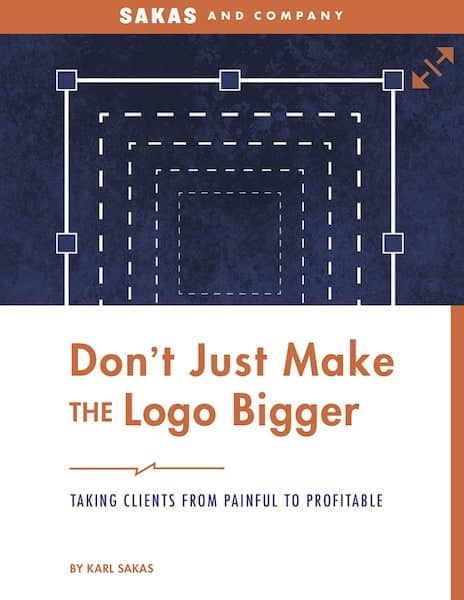As your agency reputation grows and your sales pipeline improves, you need to start saying “no” to more opportunities. I call this the agency Sales Selectiveness Continuum:
1) Early in your agency, you don’t say “no” to anything; you need the money.
2) Then you say “no” to bad options so you can focus on good options.
3) Eventually, you need to say “no” to good options because you can choose great options instead.
4) Once you’re having to say “no” to great options because you don’t have the bandwidth, it means it’s time to raise prices… several months ago.
Where are you currently on the agency Sales Selectiveness Continuum? Let’s take a closer look at each of the four stages, including—from my experience—where your agency ideally should be at that point in time.
If you’re struggling with current clients, see my article on ranking which ones to grow vs. fire.
4 Stages of the Sales Selectiveness Continuum
Knowing your current stage will help you measure where you stand relative to other agencies. Once you know that, you can identify how to move to the next stage.
Note that my year estimates overlap—that’s because some agencies are better at quickly building strong marketing and sales pipelines, which is a good thing.
What if you want to stay where you are? You can stay put, of course, but life is easier at later stages in the Sales Selectiveness Continuum—you’re a partner instead of a vendor, you close sales more easily, and you aren’t as worried about making payroll.
Stage 1 (at 1-3 years): Say “yes” to everything
When you start your agency, you can’t afford to say “no”—you need to get revenue in the door. Indeed, you’ll initially say “yes” to nearly everything because you don’t have much choice.
This can feel uncomfortable—it means ignoring red flags because you need the money. (Ideally, you’d be selective from the beginning, but I understand that most people don’t have the cash reserves to negotiate that approach.)
By your second year in business, you should be moving on to Stage 2 (where you’re saying “no” to those bad options).
Stage 2 (at 2-4 years): Say “no” to bad options
As you build your agency’s marketing and sales pipeline, you’ll start attracting good sales opportunities. As those grow, you can afford to say “no” to bad opportunities.
This is a great feeling—you’ll see red flags, and you’ll feel [more] confident about turning down the business. Maybe not every time, but increasingly so.
By your fourth year in business, you should be moving on to Stage 3 (where you’re saying “no” to good options so you can take the great ones).
Stage 3 (at 3-6 years): Say “no” to good options
As you specialize in a client-vertical industry, you can become even more selective. Eventually, you’ll start saying “no” to some of those good sales opportunities so you can say “yes” to great sales opportunities.
After all, you won’t have room to handle your dream clients if you’re busy handling so-so clients. This can take some juggling, but it reinforces why you shouldn’t over-commit to mediocre clients. It also reinforces the importance of specialization. As Philip Morgan notes, there’s much value in repeatability.
Some agencies will reach Stage 3 in just a few years, if they’re really good at their own marketing and sales efforts. For others, it will take longer.
By your sixth year in business, you should be moving on to Stage 4 (where you’re saying “no” to great options because you have so many.
Stage 4 (at 5-10 years): Say “no” to great options
As you approach a decade in business—and ideally sooner, if you’re good at this—you’ll be overwhelmed with great sales opportunities. You’re probably following many of these 37 sales tips.
At this point, you’ll need to turn some of those great opportunities because you don’t have the capacity to handle them. This may seem like a problem—but it’s a nice problem to have.
Once you hit Stage 4, it’s time to raise prices. (And probably past time.) You’ll likely drop back to Stage 3 or even Stage 2 (in terms of what you say “no” to), but the still-strong sales pipeline should keep you profitable (and then things will get better from there) as your standards go up.
To decide which of your current clients need to go, see my article on ranking which clients to grow vs. fire, and then follow my advice on firing bad clients.
If you’re struggling to reach Stage 4, examine your overhead expenses. If you’re growing staff faster than your revenue—or you’ve committed to a fancy, expensive office based on optimistic projections instead of reality—you’ll find it harder to move up, because you have too many “mouths to feed.” When you have excessive overhead, you’ll feel pressure to be less selective, because you need the revenue.
Acting on where your agency falls in the Sales Selectiveness Continuum
From the list above, find your current Stage and compare it to how many years you’ve been in business. Are you ahead of schedule, behind schedule, or on track?
The more you can do the strengthen your pipeline, the easier it is to advance on the Sales Selectiveness Continuum, and to break out of the feast-or-famine cycle that plagues so many agencies.
Question: What will it take to move your agency to the next stage in the Sales Selectiveness Continuum?


